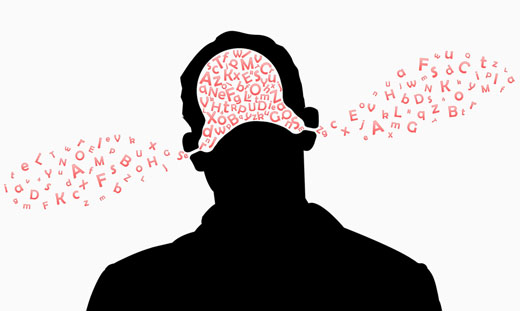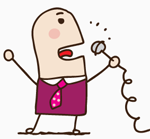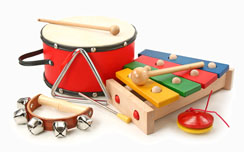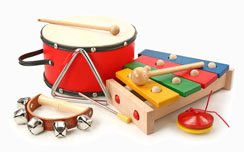Did you jam on the keys at age five? Sing since you wore diapers? Or did you just pick up music a year ago?
The amount of music in your life directly affects your ability to understand language. The longer you have played, the better your language skills[4]. How is this possible? What are the hidden connections between music and language? Is it too late to improve your language skills through music?
Understanding the distinct sounds of language begins at infancy[4]. As a child, you listened to lullabies, invented your own songs, and played toy instruments. Each time you heard a familiar tune or hit a wooden spoon against a metal pot, you increased your brain’s ability to understand the rhythms, syllables, and distinct sounds of language[5]. Simple songs helped you learn how to communicate with words and learn new vocabulary[4, 8].

While musical activities can help children learn language, musical training in an instrument or voice increases language learning in both children and adults[4]. Why? Musical training increases the brain’s ability to discern between correct and incorrect sounds similarly to discerning between correct and incorrect pitches or rhythms[4, 3]. How is this helpful? Well, for example, a musician who does not understand Spanish will learn quicker because he or she can pick out the correct rhythms, pitch, and inflections of each distinct word[4,7]. In fact, musicians even detect emotion in language better than those without musical training[4].
Practical ways to improve your language skills with music
1. Sing – a lot!

Singing releases stress, helps you express emotion, and builds your brain’s verbal abilities. If you have children or teach a class, you can easily incorporate songs into daily activities like walking the dog, cleaning, or going to the park. Extra bonus: you will increase your child’s verbal abilities, too! (Not too sure about the dog, though.)

2. Take up a musical instrument or take voice lessons.
Even six months of basic keyboard can increase your language skills[4]. You do not have to be the next Lizst to benefit from musical training. Voice or drum lessons will help build up the language regions of your brain.
3. Sing in a foreign language.
Increase your foreign language skills by singing songs in a different language. Start with simple nursery songs like “Frere Jacques” or the Japanese “Cherry Blooms”. Work your way up to more difficult songs or take advantage of worldwide music stores (like iTunes) and learn pop songs from other cultures.
Classroom and therapy ideas
1. Use songs and simple rhythm games with special needs children.
Music therapy increases the language skills of children with Down’s Syndrome[1]. Anecdotal evidence suggests that music can help children with other special needs like autism. When incorporating music with a special needs child, keep music games simple and remain sensitive to his or her needs. For example, drumming might overstimulate a child with severe autism. Singing a soothing song in a quiet room might be a better alternative.

2. Add rhythm instruments to the daily routine.
As students sing a song, encourage them to clap their hands or stomp their feet in rhythm. Have a box of rhythm instruments available for impromptu music making.
3. Basic keyboard lessons.
With a few songbooks, headphones, and an inexpensive electronic keyboard, set up a keyboard station in the classroom. Students who finish their work early can spend time at the keyboard. Encourage group learning.
Do you want to increase your verbal brainpower? Then sign up for community keyboard lessons, join the local choir, or take a drum lesson. Sing silly songs with your kids.
Even if you never played an instrument in your life, it is never too late to boost your brain with music.
Show article sources
Sources
- Bennett, S. (2010). Down Syndrome Online.
- Masataka, N. (2007). Music, evolution and language. Developmental Science, 10(1), 35-39. doi:10.1111/j.1467-7687.2007.00561.x.
- Magne, C., Schön, D., & Besson, M. (2006). Musician Children Detect Pitch Violations in Both Music and Language Better than Nonmusician Children: Behavioral and Electrophysiological Approaches. Journal of Cognitive Neuroscience, 18(2), 199-211. doi:10.1162/089892906775783660.
- Moreno, S. (2009). Can Music Influence Language and Cognition?. Contemporary Music Review, 28(3), 329. Retrieved from MasterFILE Premier database.
- Legg, R. (2009). Using music to accelerate language learning: an experimental study. Research in Education, (82), 1-12. Retrieved from Professional Development Collection database.
- Paquette, K., & Rieg, S. (2008). Using Music to Support the Literacy Development of Young English Language Learners. Early Childhood Education Journal, 36(3), 227-232. doi:10.1007/s10643-008-0277-9.
- Brown, S. (2005). Sound of Music Gives Feel for Language. Science Now, 3. Retrieved from MasterFILE Premier database.
- Honig, A. (2004). Communicating With Babies Through Music. Early Childhood Today, 18(5), 24. Retrieved from MasterFILE Premier database.
- Moore, P. (2009). Singing Forges a Link Between Music and Language. Teaching Music, 17(2), 57. Retrieved from MasterFILE Premier database.









wondering if you might have specific suggestions for apps for I-Pad. Also, how to get the school to write an IEP goal that reflects the need for music to be a learning tool for language development.
thanks,